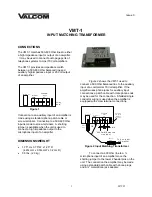
- 36 -
. . . ADDENDUM FOR DIFFERENTIAL PRESSURE TRANSMITTERS:
SELECTABLE OUTPUT FUNCTIONS
5.0 POLYNOMIAL 1 (5th order)
Available for HART version
The polynomial function, applied to the transmitter input (x) expressed
in % of the calibrated span, has the following form:
Out =
±
A
0
±
A
1
(x)
±
A
2
(x
2
)
±
A
3
(x
3
)
±
A
4
(x
4
)
±
A
5
(x
5
)
where (x) and Out should be normalized in the range 0 to 1 for
calculation purpose, with following Out meaning:
Out = 0 means Analog out 4 mA
Out = 1 means Analog out 20 mA
This function can be used for linearization purpose: the user can plot the
characteristic curve of the input and find, using a mathematical method,
the parameters of the polynomium that better approximate the plotted
curve. Check, after the calculation, if the maximum error is compatible
with the application.
The following are some application examples.
5.1 CYLINDRICAL VESSEL
Using the polynomial function applied to a level transmitter installed in
a horizontal cylindrical vessel it is possible to transmit the measure of
level in term of partial volume. Some different cases should be
considered:
a) Cilindrical vessel with flat ends (not often used. Fig. 5a). Transmitter
measuring the whole vessel heigth.
The following polynomium gives the area of the circular section in
relation to the heigth h (heigth of the liquid in the vessel).
Out = - 0.02 + 0.297 h + 2.83 h
2
- 4.255 h
3
+ 3.5525 h
4
-1.421 h
5
Being both the input h and the output Out normalized, i.e. in the range
0 to 1 (or 0% to 100%), the vessel diameter corresponding to a circular
area equal to 1 (100%) will be "normalized" by a "K" factor of the
following value :
K = 2 •
√
1/
π
= 1.12838
The volume of the liquid contained in the vessel, at heigth = h will be
V = Out • (d/1.12838)
2
• L
where d = vessel diameter and L = vessel length.
The non conformity error is within 0.1% between 0.5% and 99.5% of h,
0.2% at 0% and 100%.
b) Cilindrical vessel with hemispherical ends (see Fig. 5b). Transmitter
measuring the whole vessel heigth.
The same polynomium can be used also for the cylindrical vessel with
hemispherical ends. To obtain the volume contained in the vessel can
be used the following empyrical formula:
V = Out • (d/1.12838)
2
• (L + 2/3 d)
The non conformity error depends on the ratio between diameter and
length of the vessel: for ratio
≥
5 to 1 the error is
≤
0.25%. The
polynomium found with mathematical method gives an error of
±
0.15%.
c) Cilindrical vessel with elliptical or pseudoelliptical ends (see Fig. 5c).
Transmitter measuring the whole vessel heigth.
The same polynomium can be used also for the cylindrical vessel with
elliptical or pseudoellipticall ends. To obtain the volume contained in
the vessel can be used the following empyrical formula:
V = Out • (d/1.12838)
2
• (L + 2/3 m)
where m is the length of the minor ellipse axis (see Fig.5c)
The non conformity error depends on the ratio between the diameter
and the length of the vessel: for ratio
≥
5 to 1 the error is
≤
0.25%. The
polynomium found with mathematical method gives an error of
±
0.15%.
Fig. 5a
Fig. 5c
Fig. 5b
d
















































